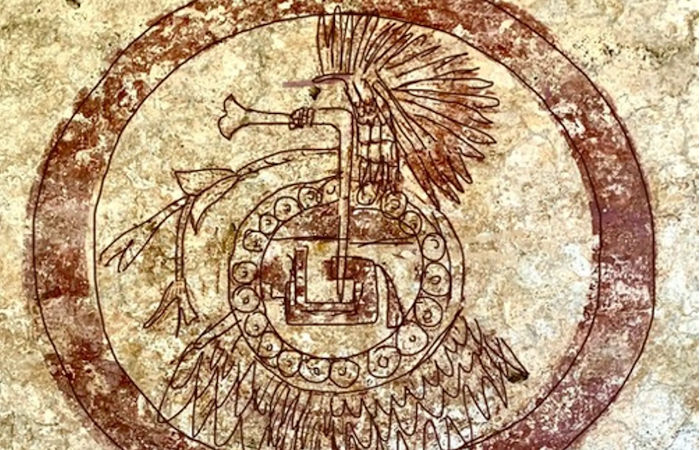Conny Waters - AncientPages.com - A mural of an Aztec rabbit God of alcohol is not something anyone expected to across inside a church, but that's exactly what surprised workers experienced in Mexico. A team of restorers commissioned to repair the building's main structure was astounded when the workers suddenly noticed pre-Hispanic iconography in a Catholic Church in Tepotzlán, Mexico.
Credit: INAH
The wall painting was hidden under several layers of whitewash in a corner chapel at the Ex Convento de la Natividad (the former Convent of the Nativity), the National Institute of Anthropology and History (INAH) said in a press statement.
The mural consists of a red circle measuring approximately one metre. Within the circle there are renderings of several pre-Columbian images, including an axe, a chimalli or shield, a sprig of flowers and a feathered headdress or “penacho,” which was traditionally worn by a member of the Aztec aristocracy.
"The corner chapels are known as “capillas posas” (posing chapels) and—while their significance has not yet been definitively established—experts believe that they were built to shelter a priest and his accouterments during services held to expedite the mass conversion to Christianity of Indigenous people. Only three corner chapels remain standing at the site, and none are in particularly good condition, and only one has been found to contain the circle with the pre-Columbian symbols," Art News reports.
Credit: INAH
Specialists who analyzed the mural say the image is linked to the patron god Tepoztécatl also known by his calendrical name, Ometochtli ("two-rabbit"). According to Aztec mythology, Tepoztécatl was the son of Patecatl.
Patecatl, the father of 400 rabbits, was a god of healing and fertility and the ‘lord of the root of pulque,’ the oldest alcoholic beverage, made from the maguey (agave) plant and known as the ‘Drink of the Gods’. The Aztec Gods of Drunkenness held bunny-like characteristics.
"Even though they are often referred to as a group of four hundred rabbits, the context implies they were innumerable. They lived in harmony and rarely got into tiffs. Unlike other creatures that were frequently involved in fights and battles with the gods and demigods, the Centzon Totochtin preferred to stay away from any sort of commotion. However, certain things did agitate the little creatures.
Credit: INAH
They were believed to be alcoholics and could attack or hurt others due to alcoholism. Unable to handle the amount of alcohol they consumed, they were feared by others when spotted with intoxicating liquids.
If someone threatened or troubled the creatures under the influence, they would surely be killed or hurt. This gave birth to the popular saying, "drunk as 400 rabbits", which is said to someone who has had a lot of alcohol. Myths claim that the rabbits drank pulque, which, as mentioned, is the juice of maguey or fermented agave.
According to myths, the main bunny gods were Macuil Tochtli – "Five Rabbit," Tepoztecatl (Ome Tochtli) – "Two Rabbit," Tequechmecauiani – "God of Hanging," Colhuatzincatl – "The Winged One," Techalotl – "God of Dance," Toltecatl – "God of Early Civilization," and Tezcatzoncatl – "The Straw Mirro," Sebastian Berg writes in the book Aztec Mythology: The Gods and Myths of Ancient Mexico.
The memory of the past Aztec gods have not been entirely forgotten. A yearly pilgrimage to a nearby mountain that contains the archaeological site El Tepozteco, which has a temple to Tepoztecatl is still a tradition among local communities. Tepoztecatl was worshipped by the Nahuatl-speaking Aztecs who inhabited the area and most likely provided much of the workforce and labor on the convent's construction.
Credit: INAH
Restorers were aware of existing markings of a similar size on a nearby wall dating from a similar era, between 1555-1580, when the Church was first erected for an order of Dominicans but noted that all of those were definitively Christian markings associated with the Virgin Mary. INAH said in a statement that it is possible that the new find relates to Tepoztécatl.
See also: More Archaeology News
According to scientists, the pre-Columbian mural could shed more light on the troublesome relationship between Mexico's indigenous inhabitants and the Catholic church, which sought to control cultural expression after the Spanish conquest in the 16th century.
Written by Conny Waters - AncientPages.com Staff Writer
